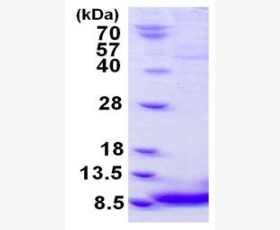Recombinant Human Chloride Intracellular Channel Protein 1/CLIC1
| Product name: | Recombinant Human Chloride Intracellular Channel Protein 1/CLIC1 |
| Source: | E. coli |
| Purity: | Greater than 95% as determined by reducing SDS-PAGE. |
| Buffer Formulation: | Lyophilized from a 0.2 μm filtered solution of 20mM Tris, 150mM NaCl, pH 8.0. |
| Applications: | Applications:SDS-PAGE; WB; ELISA; IP. |
| Storage: | Avoid repeated freeze/thaw cycles. Store at 2-8 oC for one month. Aliquot and store at -80 oC for 12 months. |
| UOM: | 100ug/50ug/200ug/1mg/1g |
| Source | E. coli |
| Description | Recombinant Human CLIC1 is produced by our E.coli expression system and the target gene encoding Met1-Lys241 is expressed with a 6His tag at the N-terminus. |
| Names | Chloride Intracellular Channel Protein 1, Chloride Channel ABP, Nuclear Chloride Ion Channel 27, NCC27, Regulatory Nuclear Chloride Ion Channel Protein, hRNCC, CLIC1, G6, NCC27 |
| Accession # | O00299 |
| Formulation | Lyophilized from a 0.2 μm filtered solution of 20mM Tris, 150mM NaCl, pH 8.0. |
| Shipping |
The product is shipped at ambient temperature. |
| Reconstitution |
Always centrifuge tubes before opening. Do not mix by vortex or pipetting. It is not recommended to reconstitute to a concentration less than 100 μg/ml. Dissolve the lyophilized protein in ddH2O. Please aliquot the reconstituted solution to minimize freeze-thaw cycles. |
| Storage |
Lyophilized protein should be stored at < -20°C, though stable at room temperature for 3 weeks. Reconstituted protein solution can be stored at 4-7°C for 2-7 days. Aliquots of reconstituted samples are stable at < -20°C for 3 months. |
| Purity |
Greater than 95% as determined by reducing SDS-PAGE. |
| Endotoxin | Less than 0.1 ng/µg (1 IEU/µg) as determined by LAL test. |
| Amino Acid Sequence |
MGSSHHHHHHSSGLVPRGSHMAEEQPQVELFVKAGSDGAKIGNCPFSQRLFMVLWLKGVTFNVTT VDTKRRTETVQKLCPGGQLPFLLYGTEVHTDTNKIEEFLEAVLCPPRYPKLAALNPESNTAGLDI FAKFSAYIKNSNPALNDNLEKGLLKALKVLDNYLTSPLPEEVDETSAEDEGVSQRKFLDGNELTL ADCNLLPKLHIVQVVCKKYRGFTIPEAFRGVHRYLSNAYAREEFASTCPDDEEIELAYEQVAKAL K
|
| Background | Chloride Intracellular Channel Protein 1 (CLIC1) belongs to the Chloride Channel CLIC family and contains one GST C-terminal domain. CLIC1 can be expressed in various cell types, but it is especially prominent in the heart, placenta, liver, kidney, and pancreas. CLIC1 can insert into membranes and form chloride ion channels. The channel activity depends on the pH. CLIC1 membrane insertion seems to be redox-regulated and may occur only under oxydizing conditions. CLIC1 is also involved in the regulation of the cell cycle. |














